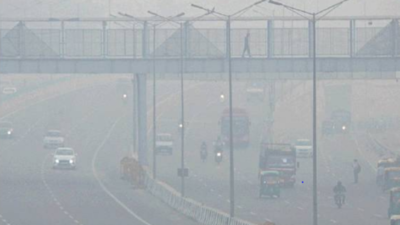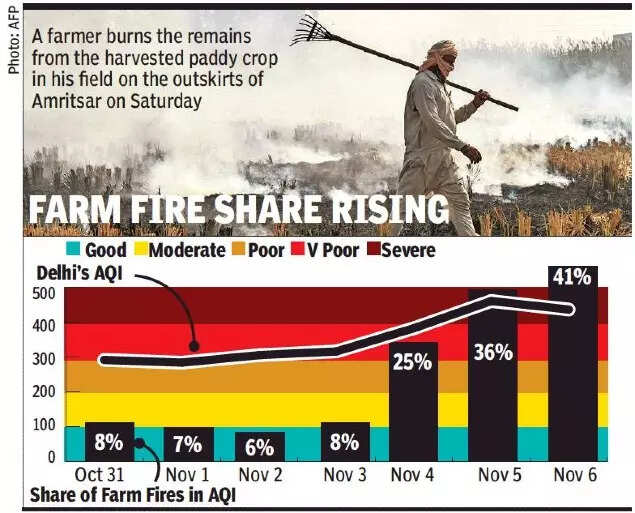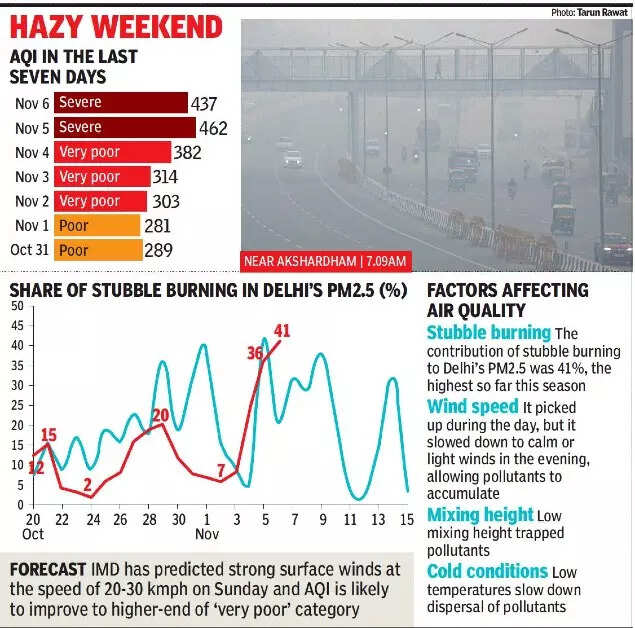Top Searches
- News
- City News
- delhi News
- Delhi chokes on ‘severe’ air for second day in a row
Delhi chokes on ‘severe’ air for second day in a row
Delhi chokes on ‘severe’ air for second day in a row

The overall AQI in the city saw a marginal improvement from 462 on Friday to 437 on Saturday.
NEW DELHI: Delhiites continued to breathe a deadly cocktail of toxic gases with the air quality remaining “severe” for the second day after Diwali, as pollutants largely remained trapped over the region even though winds picked up for a few hours. Meanwhile, the share of farm fires in the city’s PM2.5 pollution rose to 41% as stubble-burning began to peak in the neighbouring states.
The overall AQI in the city saw a marginal improvement from 462 on Friday to 437 on Saturday.

Smog appeared again in the morning, reducing visibility to 600-800 metres between 5.30am and 9.30am. Each of the last three days has seen the share of stubble-burning in the city’s PM2.5 level touch a new season’s high.
Slight improvement may make air quality ‘very poor’
It was 25% on Diwali and 36% on Friday.
According to experts, air quality remained in the “severe” zone mainly due to rising share of stubble burning, calm wind conditions, low temperatures, low mixing height and transportation of dust from Rajasthan.

The minimum temperature was 14.7 degrees Celsius, which prevented the dispersal of pollutants while the low mixing height kept the toxic layer of air close to the land surface.
The wind speed increased during the day but calm conditions were again observed later in the day, causing accumulation of pollutants. “The wind speed at Safdarjung and Palam was reported around 10 to 15kmph till 4pm, which then slowed down to calm or light winds. Wind direction remained from westerly to north-northwesterly,” said R K Jenamani, senior scientist at India Meteorological Department (IMD).
He added, “Fog/smog conditions improved in Delhi on Saturday morning as compared to Friday. Shallow fog was observed at visibility range of 600 to 800 meter at Safdarjung and Palam from 5.30 am to 9.30am. Visibility remained at 800-1,200m later in the day with a smog persisting.”
Mahesh Palawat of Skymet Weather, a private weather forecasting agency, said, “The wind speed was almost calm on Friday night but the wind speed picked up on Saturday for around four hours, helping in dispersal of pollutants. However, wind later again slowed down but moderate to strong winds are expected on Sunday.”
Dipankar Saha, former head of CPCB’s air laboratory, said, “Low wind speed, low mixing height and low temperatures made the pollutants accumulate in the atmosphere. At the same time, as the wind direction was westerly to north-westerly, the emissions from Punjab and Haryana and dust from Rajasthan side were transported to Delhi region.” He added that the air quality is likely to gradually improve if there is improvement in ventilation, wind speed or mixing height. The Central Pollution Control Board’s central control room data showed that Delhi-NCR's average 24-hour PM10 and PM2.5 concentrations were 429 micrograms per cubic metre and 298 micrograms per cubic metre, respectively, at 7pm. The standard PM10 and PM2.5 is 100 and 60 micrograms per cubic metre, respectively.
With IMD forecasting strong surface winds at 20-30 kmph on Sunday, the air quality may see an improvement. System of Air Quality and Weather Forecasting And Research (SAFAR), a pollution monitoring body under the Union ministry of earth sciences, said, “Delhi’s AQI is likely to improve to upper end of ‘very poor’ category as surface winds are becoming stronger, dispersing air pollutants. Strong northwesterly winds enhance transport of emissions from stubble burning. Share of crop residue burning emissions in PM2.5 is 41% (Effective fire count 5,159).”
The overall AQI in the city saw a marginal improvement from 462 on Friday to 437 on Saturday.

Smog appeared again in the morning, reducing visibility to 600-800 metres between 5.30am and 9.30am. Each of the last three days has seen the share of stubble-burning in the city’s PM2.5 level touch a new season’s high.
Slight improvement may make air quality ‘very poor’
It was 25% on Diwali and 36% on Friday.
According to experts, air quality remained in the “severe” zone mainly due to rising share of stubble burning, calm wind conditions, low temperatures, low mixing height and transportation of dust from Rajasthan.

The minimum temperature was 14.7 degrees Celsius, which prevented the dispersal of pollutants while the low mixing height kept the toxic layer of air close to the land surface.
The wind speed increased during the day but calm conditions were again observed later in the day, causing accumulation of pollutants. “The wind speed at Safdarjung and Palam was reported around 10 to 15kmph till 4pm, which then slowed down to calm or light winds. Wind direction remained from westerly to north-northwesterly,” said R K Jenamani, senior scientist at India Meteorological Department (IMD).
He added, “Fog/smog conditions improved in Delhi on Saturday morning as compared to Friday. Shallow fog was observed at visibility range of 600 to 800 meter at Safdarjung and Palam from 5.30 am to 9.30am. Visibility remained at 800-1,200m later in the day with a smog persisting.”
Mahesh Palawat of Skymet Weather, a private weather forecasting agency, said, “The wind speed was almost calm on Friday night but the wind speed picked up on Saturday for around four hours, helping in dispersal of pollutants. However, wind later again slowed down but moderate to strong winds are expected on Sunday.”
Dipankar Saha, former head of CPCB’s air laboratory, said, “Low wind speed, low mixing height and low temperatures made the pollutants accumulate in the atmosphere. At the same time, as the wind direction was westerly to north-westerly, the emissions from Punjab and Haryana and dust from Rajasthan side were transported to Delhi region.” He added that the air quality is likely to gradually improve if there is improvement in ventilation, wind speed or mixing height. The Central Pollution Control Board’s central control room data showed that Delhi-NCR's average 24-hour PM10 and PM2.5 concentrations were 429 micrograms per cubic metre and 298 micrograms per cubic metre, respectively, at 7pm. The standard PM10 and PM2.5 is 100 and 60 micrograms per cubic metre, respectively.
With IMD forecasting strong surface winds at 20-30 kmph on Sunday, the air quality may see an improvement. System of Air Quality and Weather Forecasting And Research (SAFAR), a pollution monitoring body under the Union ministry of earth sciences, said, “Delhi’s AQI is likely to improve to upper end of ‘very poor’ category as surface winds are becoming stronger, dispersing air pollutants. Strong northwesterly winds enhance transport of emissions from stubble burning. Share of crop residue burning emissions in PM2.5 is 41% (Effective fire count 5,159).”
FacebookTwitterLinkedinEMail
Start a Conversation
end of article

